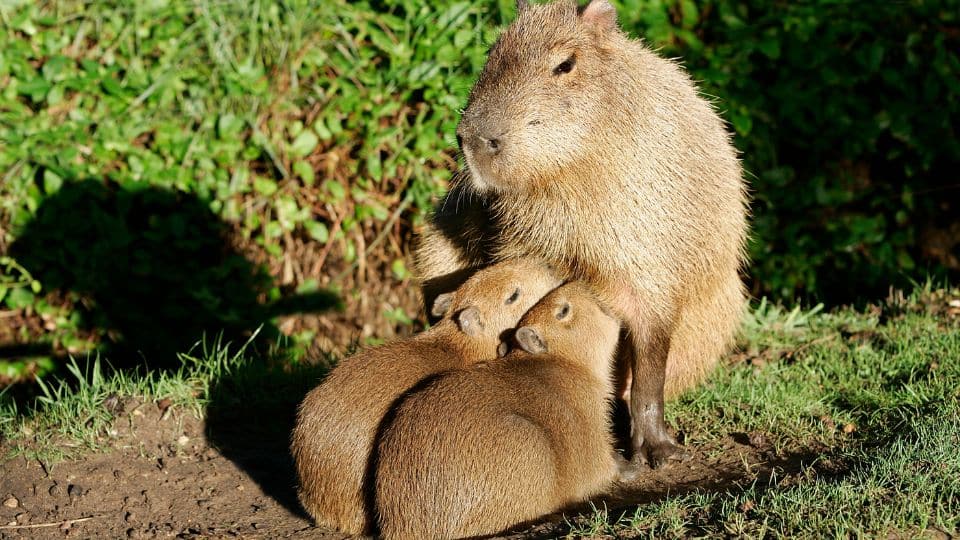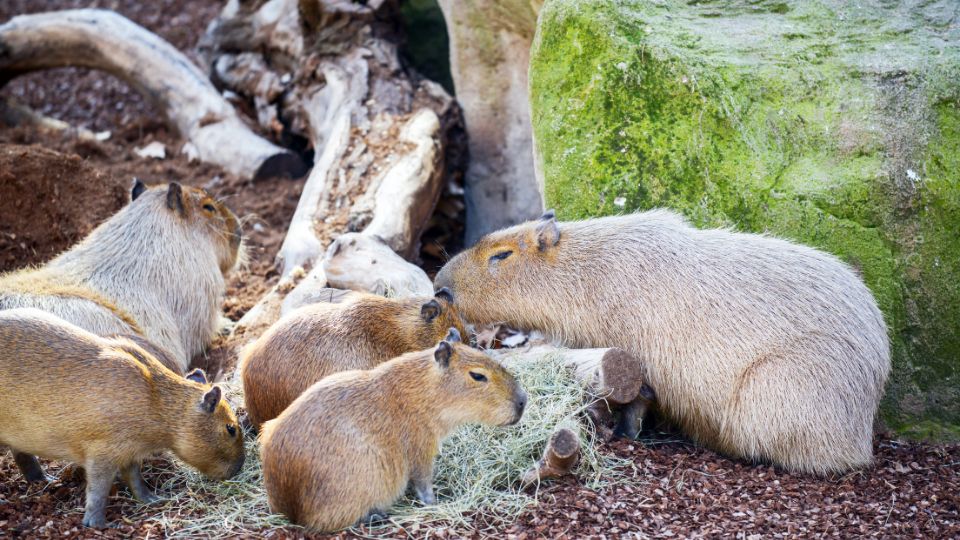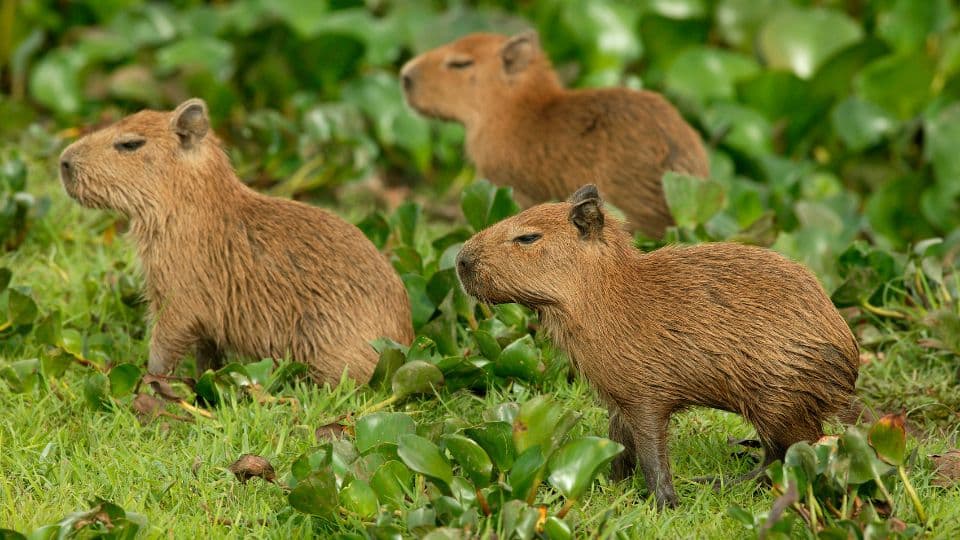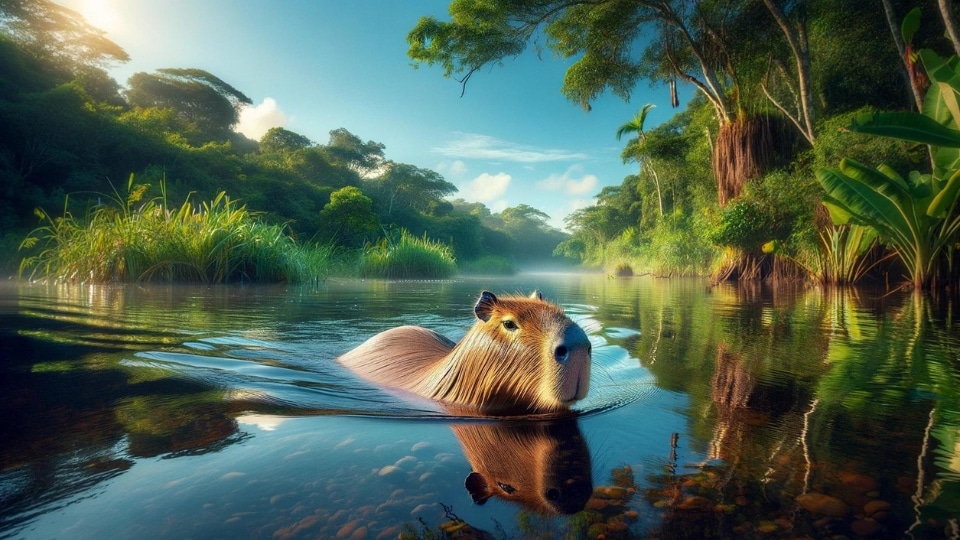A newborn capybara is affectionately known as a “pup.” At birth, these pups are a miniature version of their adult counterparts, complete with a full set of fur, open eyes, and a full set of teeth. Imagine these tiny creatures, barely the size of a small loaf of bread, yet already so perfectly formed.
This immediate state of readiness is essential for capybara pups because their habitat in the wetlands of South America is fraught with challenges and predators.
The ability to see, move, and feed shortly after birth gives these newborn capybara a significant advantage in the wild. It’s a harsh world out there, but these pups are born ready to face it.
Early Life of a Capybara Pup

The early life of a capybara pup is characterized by rapid development and communal care.
In their first week, imagine these tiny creatures, barely larger than your hand, relying entirely on milk.
This milk can come from any female in the group, not just their own mother, illustrating the remarkable trait of communal nursing.
This ensures that all pups have access to the nutrients they need, regardless of the mother’s condition or presence.
As they grow, the pups begin to eat grass, which introduces them to their future herbivorous diet.
This transition from milk to solid food is gradual, taking place over approximately 16 weeks, after which they are fully weaned.
Witnessing a pup take its first bite of grass is like watching a child take its first steps – a moment filled with anticipation and wonder.
To understand more about how these young capybaras hone their swimming skills, which are crucial for their survival, read our in-depth article on the swimming capabilities of capybaras.
Easy Table to Understand Newborn Capybaras
| Age Stage | Weight | Feeding & Diet | Development & Behavior |
|---|---|---|---|
| Birth | 2-3 pounds | Milk from any lactating female in the group | Born with fur, open eyes, and teeth. Capable of swimming and following the mother shortly after birth. |
| First Week | Same as Birth | Milk | Stays close to the mother and begins to take first steps. |
| 1-16 Weeks | Rapidly increasing | Transition from milk to grass, mixed diet | Weaning process begins, pups start to eat solid food while still nursing occasionally. |
| 4 Months | Up to 29 to 33 pounds | Weaned off milk, primarily eating grass | Fully weaned, growing quickly, learning to forage and interact within the group. |
| 1 Year | Up to 88 pounds | Grass, fruit, vegetables, and aquatic plants | Young capybaras start to show independence, may leave the family group to join others or establish new ones. |
| 18 Months | 88-146 pounds | Same as adults | Reach sexual maturity, fully grown, and integrated into the social hierarchy of their groups. |
| Adulthood | 100-174 pounds | Herbivorous diet: grass, water plants, fruits | Capable of breeding, taking part in group activities, and may assume roles such as dominant male or female. |
Growing Up Capybara

Capybara pups experience an astonishing rate of growth. From a modest birth weight of 2 to 3 pounds, they can grow to weigh an average of 88 pounds by the time they reach 18 months old.
This growth is not just physical; it includes the development of social and survival skills.
Pups learn from their elders where to find the best grazing spots, how to escape from predators, and the social dynamics of their groups.
Witnessing their growth is like watching a well-orchestrated dance of nature, where each step is crucial for survival.
These gentle giants possess not just a friendly disposition but also an athleticism that might not be immediately apparent. Their ability to run swiftly is a testament to their adaptability and survival skills in diverse environments.
Just like a baby capybara, a capybara plush toy can bring a smile to your face.
The Vulnerability of Youth

Despite their precocious nature, capybara pups are not immune to the dangers of their ecosystem.
Their youth makes them a target for predators such as jaguars, anacondas, and large raptors.
The pups’ strategy for survival is to stay close to their group and near water, where they can quickly submerge to evade threats.
The family group provides a protective structure, with adults often surrounding the more vulnerable pups to shield them from harm.
This group dynamic plays a pivotal role in the pups’ survival during their first critical months of life.
While their gentle nature often endears them to humans, this same trait brings up questions about the feasibility and legality of keeping capybaras as pets in michigan, a topic that has varying answers depending on regional laws and regulations.
Conclusion
Capybara pups, with their rapid development and communal upbringing, are a testament to the resilience and adaptability of nature.
From the moment they are born, these pups are equipped to thrive in their challenging environment.
Their growth from helpless newborns to substantial members of the largest rodent species is a journey filled with learning, adaptation, and the constant support of their family group.
As they mature, these pups will continue the cycle of life in the wetlands, each generation contributing to the survival and understanding of these remarkable creatures.
It’s a story of growth, survival, and unity that resonates deeply with our own human experiences. Learning about the charming early days of baby capybaras might pique your interest in how they compare with other rodents like nutrias at this tender stage.



